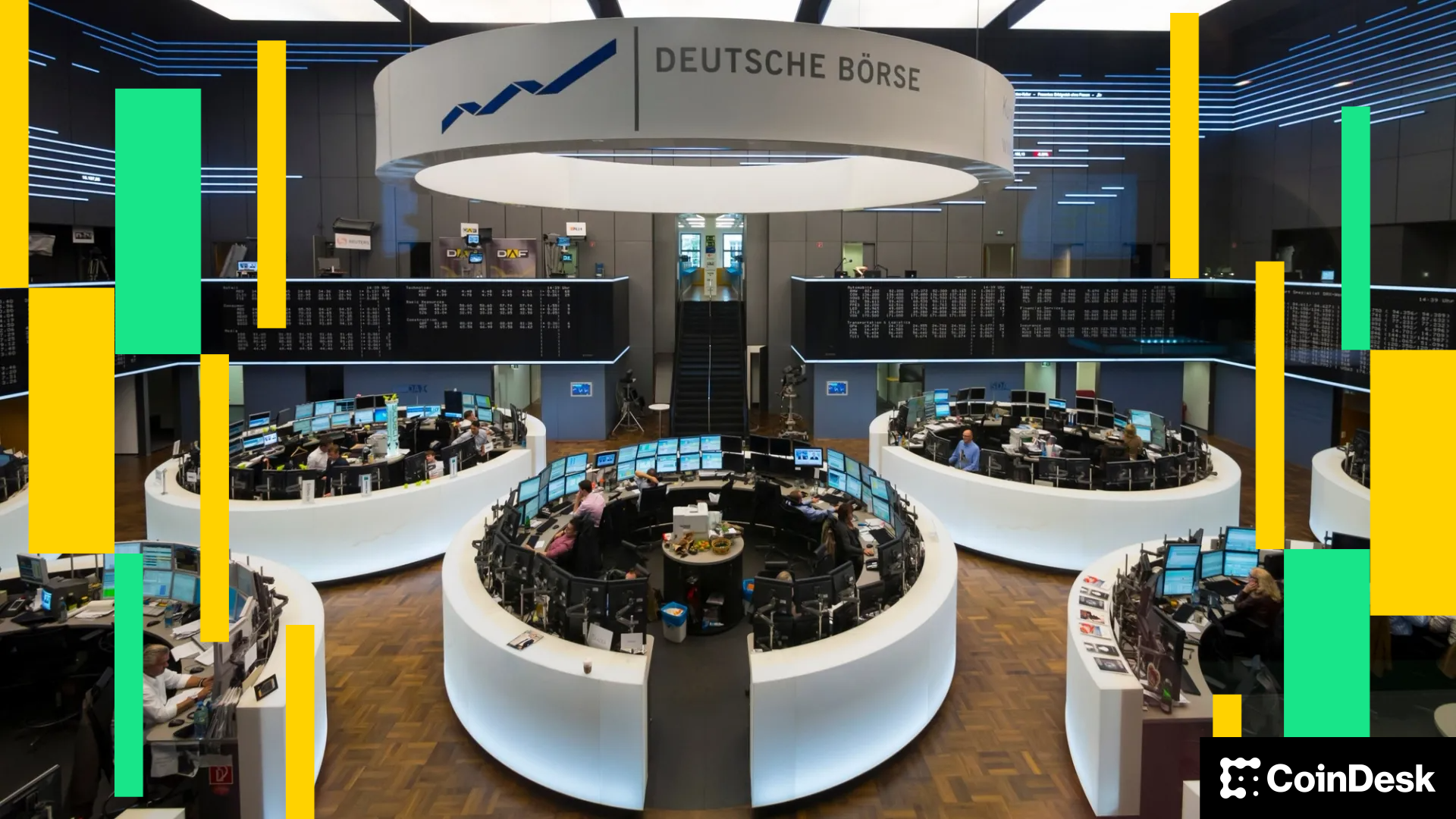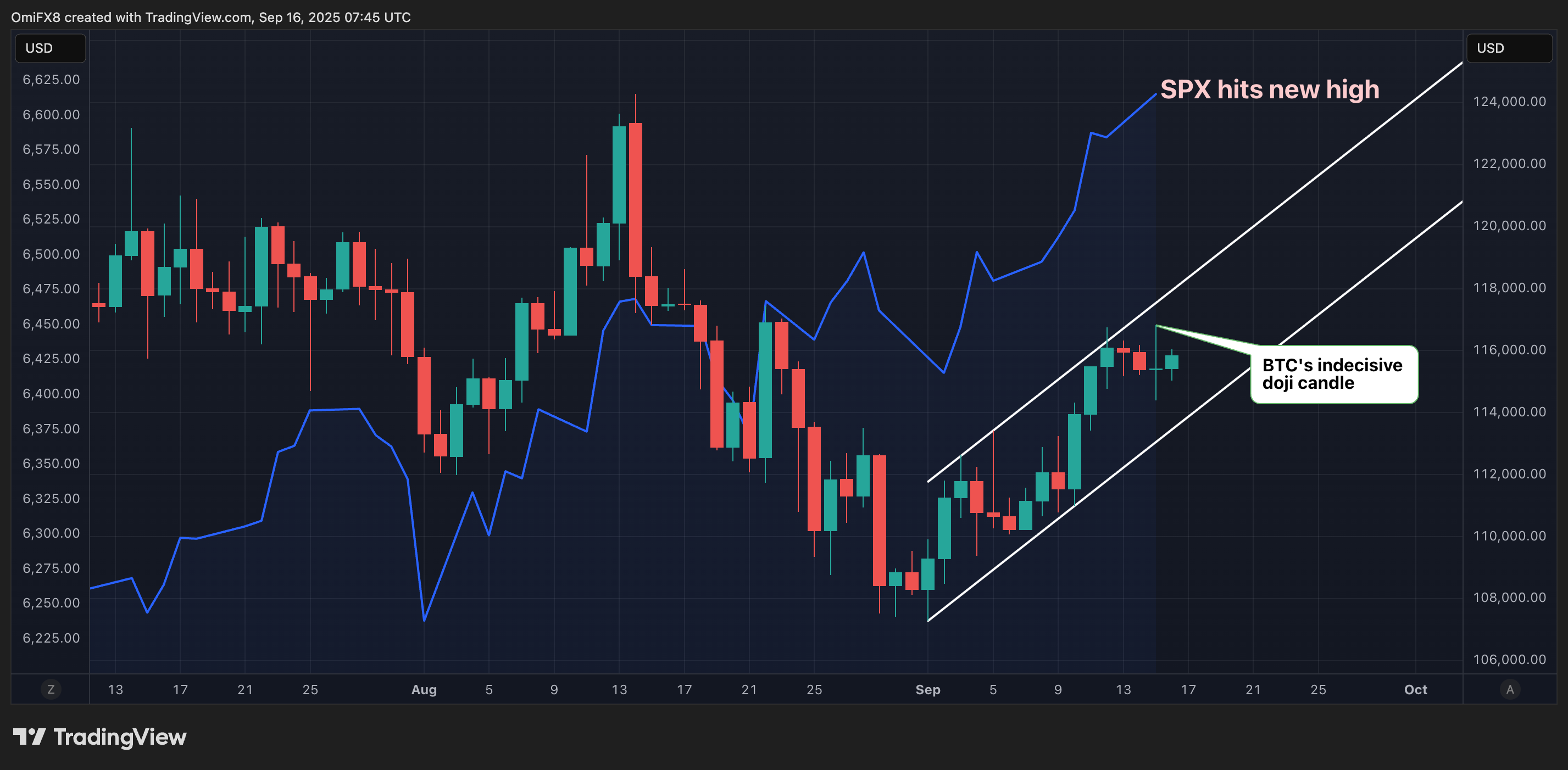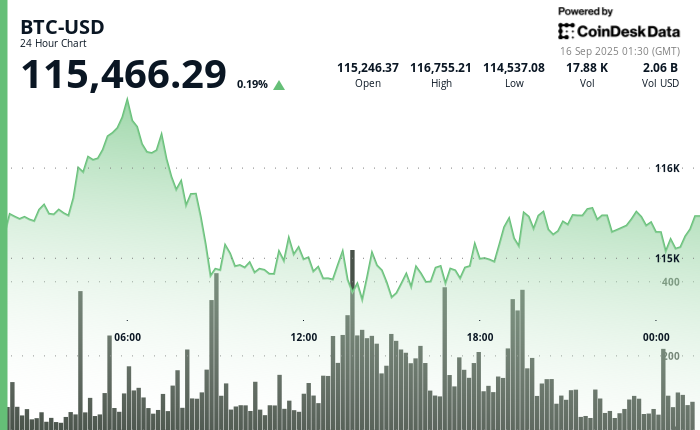Uncategorized
The Protocol: Vitalik Buterin’s Latest Proposal – Transaction Gas Cap
Welcome to The Protocol, CoinDesk’s weekly wrap-up of the most important stories in cryptocurrency tech development. I’m Margaux Nijkerk, CoinDesk’s Tech & Protocols reporter.
In this issue:
- Vitalik Buterin’s New Proposal Seeks 16.7M Gas Cap on Ethereum to Rein In Transaction Bloat
- Jack Dorsey Unveils Bitchat: Offline, Encrypted Messaging Inspired by Bitcoin
- Volkswagen ADMT Taps Solana-Based Hivemapper Bee Maps for Driverless Data
- Eigen Labs Axes 25% of Staff to Focus on Building EigenCloud
Network News
NEW ETHEREUM PROPOSAL FROM VITALIK BUTERIN: A new Ethereum proposal, co-authored by Vitalik Buterin and Toni Wahrstaetter, aims to impose a hard cap on the maximum gas a transaction can consume in a move developers say could strengthen network stability and make the chain more viable for certain applications. The proposal, EIP-7983, suggests limiting individual transactions to 16,777,216 gas (2²⁴) — a sharp change from the current design, which technically allows a single transaction to consume the gas allocation of an entire block. As a design choice, that introduces several performance and security challenges. When a single transaction consumes nearly all the available gas, it disrupts the distribution of workloads across the network and tends to make block execution less efficient. So the proposed cap is expected to simplify engineering challenges and aligns with Ethereum’s shift toward modularity, though it may require splitting large transactions. — Shaurya Malwa Read more.
JACK DORSEY UNVEILS BITCHAT WHITEPAPER: Jack Dorsey, founder of Twitter (now X) and fintech company Block (SQ), published a whitepaper for Bitchat, a decentralized messaging protocol that enables fully encrypted communication without the internet. Bitchat would operate over Bluetooth Low Energy (BLE), allowing nearby devices to form a mesh network that relays messages hop-by-hop, according to the whitepaper. When a message is sent, it would travel across nearby devices acting as temporary nodes until it reaches its recipient, making it resilient in offline or censored environments. While not making explicit references to Bitcoin, the cryptocurrency or the blockchain, Dorsey describes Bitchat as a «decentralized, peer-to-peer messaging application,» evoking connections to the Bitcoin whitepaper’s intro in which it was described as a «peer-to-peer version of electronic cash.» — Jamie Crawley Read more.
SOLANA HIVEMAPPER AND VOLKSWAGEN TEAM UP: Volkswagen ADMT, the carmaker’s autonomous-vehicle testing subsidiary, tapped Hivemapper’s Bee Maps to support its self-driving operations with real-time mapping data. Street-level imagery collected by Bee Maps contributors using Hivemapper cameras will be used to help validate Volkswagen’s self-driving technology in an effort to boost the curbside precision of autonomous pick-ups and drop-offs, a Bee Maps spokesperson told CoinDesk. The deal highlights the growing adoption of crowdsourced geospatial data as autonomous ride-sharing firms look for more precise, up-to-date mapping infrastructure. It also showcases the growth of decentralized physical infrastructure networks (DePIN), which use blockchain incentives to crowdsource real-world data collection. Hivemapper is one of the best-known DePIN projects in the Solana ecosystem. According to the Wall Street Journal, Volkswagen’s autonomous driving unit has been testing its ‘Robotaxi’ fleet in recent months. In April, the company also announced a partnership with Uber to launch the service in U.S. markets, with pilot operations set for late 2025 and a wider rollout planned for 2026. — Margaux Nijkerk Read more.
EIGENLABS LAYS OFF STAFF AMID RESTRUCTURE: Eigen Labs, the main developer firm behind restaking protocol EigenLayer, cut its workforce by 25%, losing 29 roles, as CEO Sreeram Kannan said he restructured the company to focus on developing EigenCloud, which he called a “verifiable” alternative to existing, opaque cloud services. The Seattle-based startup said the dismissals were not a cash-crunch response. The news comes as the firm has dealt with its fair share of blowback, from not having certain key mechanisms in place at the launch of its main product, to having leading Ethereum Foundation figures receive big payouts for advisory roles. EigenLayer was once one of the buzziest projects in crypto, reaching $20 billion in total value locked in June 2024. It now has $12 billion. — Francisco Rodrigues Read more.
In Other News
- Bit Digital (BTBT) is now the owner of more than 100,000 ether (ETH) after swapping out its bitcoin stack along with a $172 million capital raise for even more of the world’s second-largest crypto. From a holding of 24,434 ETH as of the end of March, Bit Digital now has some 100,603 ETH ($189.2 million) making it one of the largest corporate ETH holders, the company said. Bit Digital revealed its plans to focus solely on ETH staking last month in a move that wasn’t entirely unexpected given the more challenging environment bitcoin miners have experienced since last year’s halving. — Jamie Crawley Read more.
- U.S. President Donald Trump’s Media & Technology Group (NASDAQ: DJT) filed to list a crypto exchange-traded fund (ETF) that would track a selection of digital assets, the latest in a string of such efforts tied to the Trump brand. The proposed «Truth Social Crypto Blue Chip ETF» would hold a portfolio of five tokens: bitcoin (BTC), ether (ETH), solana (SOL), XRP (XRP) and cronos (CRO), according to a filing with the SEC. Eighty-five percent of the fund’s holdings would be split between bitcoin and ether. Solana would make up 8%, cronos 5% and XRP 2%. — Helene Braun Read more.
Regulatory and Policy
- The U.S. Treasury Department’s Office of Foreign Asset Control’s (OFAC) sanctions against privacy tool Tornado Cash cannot be discussed at the upcoming trial of developer Roman Storm, a federal judge ruled. At a status conference in Manhattan on Tuesday, District Judge Katherine Polk Failla initially waffled on whether she would allow expert witnesses to testify about the sanctions, which were first imposed in August 2022, removed this March and subsequently found illegal by a Texas court. After hearing arguments from both prosecution and defense, Failla decided to grant Storm’s motion in limine moving to prohibit testimony about the sanctions entirely, arguing that it would simply be too confusing for a jury to do what she described as the “mental gymnastics” of understanding why the sanctions were imposed and ultimately removed. — Cheyenne Ligon Read more.
- The U.S. Department of Justice (DOJ) charged two individuals for their role in OmegaPro, a crypto and investment Ponzi scheme that defrauded investors of over $650 million. Michael Shannon Sims, a founder and promoter of OmegaPro, and Juan Carlos Reynoso, who led OmegaPro’s operations in Latin America and some parts of the U.S., were charged on conspiracy to commit wire fraud and money laundering, according to documents published. OmegaPro was an international investment scheme that collapsed in 2022. In 2024, Andreas Szakacs, the co-founder of the scheme, was arrested in Turkey for his involvement with OmegaPro. — Parikshit Mishra Read more.
Calendar
- July 16-18: Web3 Summit, Berlin
- Sept. 22-28: Korea Blockchain Week, Seoul
- Oct. 1-2: Token2049, Singapore
- Nov. 17-22: Devconnect, Buenos Aires
- Dec. 11-13: Solana Breakpoint, Abu Dhabi
- Feb. 10-12, 2026: Consensus, Hong Kong
- May 5-7, 2026: Consensus, Miami
Uncategorized
Deutsche Börse’s Crypto Finance Unveils Connected Custody Settlement for Digital Assets

Crypto Finance, a subsidiary of Deutsche Börse Group, unveiled AnchorNote, a system designed for institutional clients who want to trade digital assets without moving them out of regulated custody.
The system integrates BridgePort, a network of crypto exchanges and custodians, enabling off-exchange settlement and connectivity to multiple trading venues. By keeping assets in custody while allowing real-time collateral movement, AnchorNote aims to improve capital efficiency and reduce counterparty risk, according to a press release.
The service allows clients to set up dedicated trading lines, with BridgePort handling messaging between venues and Crypto Finance acting as collateral custodian, the press release said. Institutions can manage collateral through a dashboard or integrate the service directly into their existing infrastructure using APIs, it said. APIs, or application programming interfaces, allow software programs to communicate directly with one another.
“Institutional clients face a constant tradeoff between security and capital efficiency,” said Philipp E. Dettwiler, head of custody and settlement at Crypto Finance. “AnchorNote is designed to bridge that gap.”
For traders, the setup eliminates the need for pre-funding exchanges while providing immediate access to liquidity across platforms. In practice, a Swiss bank could pledge bitcoin held in custody and deploy it instantly across multiple trading venues without moving the coins on-chain.
The rollout begins in Switzerland, with Crypto Finance planning to expand across Europe.
Uncategorized
Bitcoin, Ether, XRP, and Dogecoin Lag Stocks as VIX Stirs Up Some Nerves

It’s a risk-on environment, with stocks leading major cryptocurrencies higher, but Wall Street’s fear gauge, the VIX, is stirring up some nerves.
On Monday, Wall Street’s benchmark index, the S&P 500, set a record high for the fourth consecutive trading day, reaching 6,519 points. The tech-heavy Nasdaq index also hit lifetime highs, and the Dow Jones traded near the peak recorded on Thursday.
Equities rose, disregarding the bearish September manufacturing survey, as bond yields fell in anticipation of a 25-basis-point Fed rate cut on Wednesday. According to the Fed funds futures, traders expect rates to drop to 3% from the present 4.25% within the next 12 months.

Still, bitcoin (BTC) lacked clear direction, as it traded back and forth between $114,000 and $117,000, forming an indecisive Doji candle. As of writing, it changed hands at $115,860, continuing a lacklustre trading pattern below record highs of above $124,000 hit in August.
The dour price action is likely due to long-term holders continuing to take profits and countering the bullish pressure from spot ETF inflows.
Other major tokens such as ether (ETH), XRP (XRP) and dogecoin (DOGE) have lost upward momentum too.
Ethereum’s ether token has pulled back from nearly $4,800 to $4,500 in three days, having put in lifetime highs above $5,000 last month. The weakness is perplexing, as ether, popularly known as the internet bond due to its staking yield mechanism, stands to become an attractive investment with the impending Fed rate cuts.
The payments-focused XRP has pulled back to $3.00, marking a weak follow-through to the bullish breakout from the descending triangle confirmed last week. Meanwhile, dogecoin, the leading meme token by market value, has dropped sharply to 26.7 cents from 30.7 cents amid reports of whale selling.
Analysts said that a 25-basis-point rate cut could resume the slow grind higher in BTC. Meanwhile, a surprise 50 bps move could see stocks, crypto and gold go berserk.
Keep an eye on VIX and BTC vol indices
Monday’s rise in U.S. stocks was characterized by an uptick in the VIX index, which represents the options-based implied or expected volatility in the S&P 500 over the next 30 days.
The VIX rose over 6% to 15.68 points. While it still largely hovers at multi-month lows, the Tuesday spike warrants attention for two reasons: First, historically, the two have moved in opposite directions, as evident from the correlation of nearly -90 over a 90-day period.
Secondly, a breakdown in the negative correlation often precedes corrections, as noted by the quant-driven market intelligence platform Menthor Q on X.
«SPX rose with the VIX today. This often signals stretched upside positioning, traders grabbing calls or hedging downside [with puts], leaving markets vulnerable,» Menthor Q said.
The VIX is influenced by demand for options, and Tuesday’s rise in the index could have been led by traders seeking S&P 500 puts or downside protection.
Perhaps, market participants anticipate a correction following the expected 25-basis-point Fed rate cut on Wednesday.
BTC implied volatility rises
Volmex’s bitcoin implied volatility index, which represents the expected price turbulence over 30 days, also rose by 3% Monday, maintaining its positive correlation with VIX.
Note that BTC’s historic positive correlation with implied volatility indices has flipped negative since the spot ETFs went live in January last year and more so since President Trump’s electoral win in November last year.
Uncategorized
Asia Morning Briefing: Fragility or Back on Track? BTC Holds the Line at $115K

Good Morning, Asia. Here’s what’s making news in the markets:
Welcome to Asia Morning Briefing, a daily summary of top stories during U.S. hours and an overview of market moves and analysis. For a detailed overview of U.S. markets, see CoinDesk’s Crypto Daybook Americas.
Bitcoin (BTC) traded just above $115k in Asia Tuesday morning, slipping slightly after a strong start to the week.
The modest pullback followed a run of inflows into U.S. spot ETFs and lingering optimism that the Federal Reserve will cut rates next week. The moves left traders divided: is this recovery built on fragile foundations, or is crypto firmly back on track after last week’s CPI-driven jitters?
That debate is playing out across research desks. Glassnode’s weekly pulse emphasizes fragility. While ETF inflows surged nearly 200% last week and futures open interest jumped, the underlying spot market looks weak.
Buying conviction remains shallow, Glassnode writes, funding rates have softened, and profit-taking is on the rise with more than 92% of supply in profit.
Options traders have also scaled back downside hedges, pushing volatility spreads lower, which Glassnode warns leaves the market exposed if risk returns. The core message: ETFs and futures are supporting the rally, but without stronger spot flows, BTC remains vulnerable.
QCP takes the other side.
The Singapore-based desk says crypto is “back on track” after CPI confirmed tariff-led inflation without major surprises. They highlight five consecutive days of sizeable BTC ETF inflows, ETH’s biggest inflow in two weeks, and strength in XRP and SOL even after ETF delays.
Traders, they argue, are interpreting regulatory postponements as inevitability rather than rejection. With the Altcoin Season Index at a 90-day high, QCP sees BTC consolidation above $115k as the launchpad for rotation into higher-beta assets.
The divide underscores how Bitcoin’s current range near $115k–$116k is a battleground. Glassnode calls it fragile optimism; QCP calls it momentum. Which side is right may depend on whether ETF inflows keep offsetting profit-taking in the weeks ahead.

Market Movement
BTC: Bitcoin is consolidating near the $115,000 level as traders square positions ahead of expected U.S. Fed policy moves; institutional demand via spot Bitcoin ETFs is supporting upside
ETH: ETH is trading near $4500 in a key resistance band; gains are being helped by renewed institutional demand, tightening supply (exchange outflows), and positive technical setups.
Gold: Gold continues to hold near record highs, underpinned by expectations of Fed interest rate cuts, inflation risk, and investor demand for safe havens; gains tempered somewhat by profit‑taking and a firmer U.S. dollar
Nikkei 225: Japan’s Nikkei 225 topped 45,000 for the first time Monday, leading Asia-Pacific gains as upbeat U.S.-China trade talks and a TikTok divestment framework lifted sentiment.
S&P 500: The S&P 500 rose 0.5% to close above 6,600 for the first time on Monday as upbeat U.S.-China trade talks and anticipation of a Fed meeting lifted stocks.
Elsewhere in Crypto
-

 Business11 месяцев ago
Business11 месяцев ago3 Ways to make your business presentation more relatable
-

 Fashion11 месяцев ago
Fashion11 месяцев agoAccording to Dior Couture, this taboo fashion accessory is back
-

 Entertainment11 месяцев ago
Entertainment11 месяцев ago10 Artists who retired from music and made a comeback
-

 Entertainment11 месяцев ago
Entertainment11 месяцев ago\’Better Call Saul\’ has been renewed for a fourth season
-

 Entertainment11 месяцев ago
Entertainment11 месяцев agoNew Season 8 Walking Dead trailer flashes forward in time
-

 Business11 месяцев ago
Business11 месяцев ago15 Habits that could be hurting your business relationships
-

 Entertainment11 месяцев ago
Entertainment11 месяцев agoMeet Superman\’s grandfather in new trailer for Krypton
-

 Entertainment11 месяцев ago
Entertainment11 месяцев agoDisney\’s live-action Aladdin finally finds its stars





